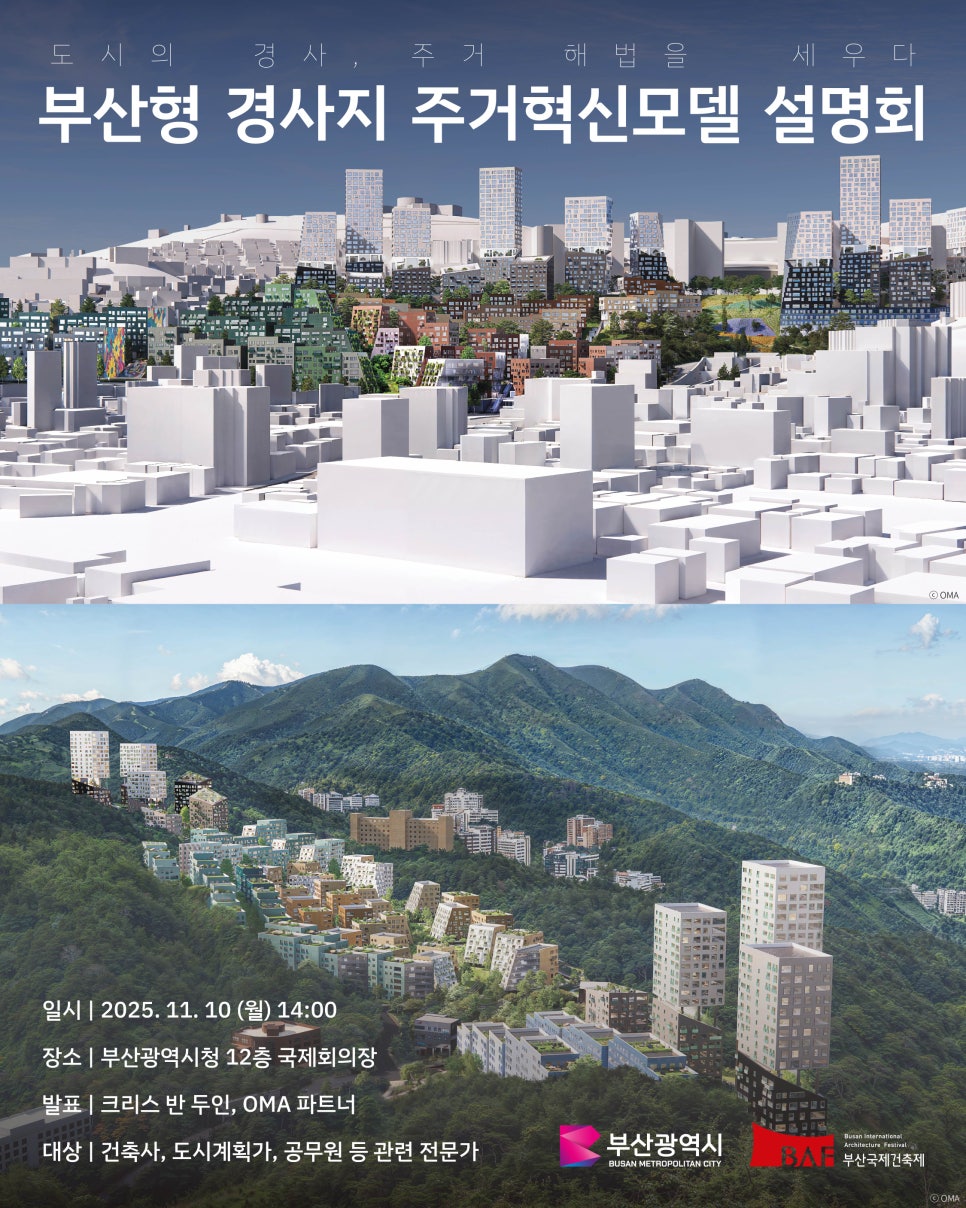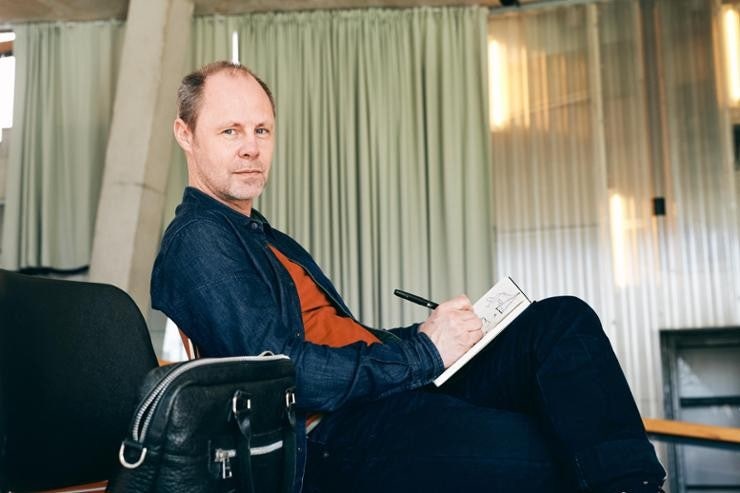Table of Contents
- Busan City presents a 'new solution' for sloped redevelopment
- Application directions for Yeongju District 2 and Anchang Village
- Expert consultations and practical reflections
- The key to the practical application of the residential model design is 'cost burden'
- Conclusion
- Frequently Asked Questions (FAQ)
Busan City presents a 'new solution' for sloped redevelopment

Busan City collaborated with the world-renowned architecture group OMA to introduce the design of the 'Busan-type sloped residential innovation model' that considers the local characteristics of Busan.
In connection with this, the city held a briefing titled 'Standing on the Slopes of the City, Building Housing Solutions' on November 10 at 2 PM in the International Conference Hall of Busan City Hall. This aims to present innovative solutions to the issues of sloped housing.

This project is being conducted as a 'pilot project for the development of Busan-type residential models for sloped redevelopment.'
The Busan International Architecture Festival Organizing Committee participates as a co-sponsor, and the global architectural firm OMA representing the Netherlands will be involved in the design study.
It is expected that this project will further improve the residential environment in Busan.

OMA is a group that seeks harmony between the city and architecture and carries out residential and cultural projects around the world. During this briefing, OMA's representative Chris van Duijn presented the 'Busan-type sloped residential model design.'
Application directions for Yeongju District 2 and Anchang Village

This model is centered around the main sloped redevelopment areas of Busan, namely Yeongju District 2 and Anchang Village.
The proposed design incorporates various housing types such as terraced, apartment, villa, and tower forms in three-dimensional combinations, aiming to create community-centered sustainable living spaces even within narrow slopes and complex urban structures.
This approach is expected to improve the residential environment by considering the characteristics of the local community and enhance the quality of life for residents.

The Yeongju District 2 redevelopment project, located in Jung-gu, Busan, is being carried out on an area of approximately 125,000 square meters. There are 1,400 members in the association, and the goal is to construct a total of 2,007 housing units. This project passed the preliminary feasibility review on August 22, 2025, and is now being actively promoted.

According to the conditions set by the Sata review resolution, it is important to adjust the location of roads and public buildings and ensure connectivity with donated facilities and parks. In addition, the matter of applying the 'Busan-type sloped residential model' must also be reflected in the plan. These elements have been outlined as review conditions.

Expert consultations and practical reflections

About 150 experts attended the briefing. They work in various fields including architects, urban planners, engineers, public officials, and local university students.
After OMA's presentation, attendees had a question-and-answer session regarding how to reflect their insights into policy and practice.

Busan City plans to establish a institutional basis through this discussion to apply the sloped residential model to redevelopment projects. Additionally, they express their intention to widely disseminate innovative cases through international cooperation in architecture and urban planning.
The key to the practical application of the residential model design is 'cost burden'

While OMA's design for the sloped residential model may receive positive evaluations in terms of urban aesthetics and architectural innovation, there are many practical constraints when it comes to actual application on-site.
The redevelopment projects in Busan are progressing slowly due to high construction and financial costs. In this context, implementing high-end and specialized designs in sloped areas like Yeongju District 2 and Anchang Village, where location competitiveness is low, is likely to incur additional design and construction costs.
Ultimately, these factors can hinder the overall feasibility of redevelopment projects.

If Busan City does not provide financial support or incentives, it will be very difficult from the perspective of local associations and construction companies to actually implement such designs.
As a result, this model is likely to remain merely a 'directional proposal at the idea level,' and significant short-term changes may be difficult to expect as a policy vision.
Conclusion

The Busan-type sloped residential model can be seen as a creative experiment to overcome the limitations of urban development.
However, in areas with low business viability, even the best designs can be difficult to realize without active public support.
If Busan City is genuinely pursuing innovation in urban regeneration, it is essential to build a practical support system beyond simple design.
#Busan-type sloped residential model, #OMA, #Busan redevelopment, #Yeongju District 2, #Anchang Village, #Busan City, #urban maintenance project, #Busan urban development, #Busan architecture, #Busan International Architecture Festival, #sloped housing, #Busan-type residential model, #Busan remodeling, #redevelopment project, #housing innovation, #Busan urban policy, #urban design, #OMA design, #Busan public architecture, #urban regeneration, #Busan slopes, #public development, #urban aesthetics, #Busan issues, #Busan news, #housing environment improvement, #urban planning, #Busan architecture, #redevelopment costs, #Busan policy
Frequently Asked Questions (FAQ)
Q. What is the Busan-type sloped residential innovation model?
The Busan-type sloped residential innovation model is a housing design for sloped redevelopment tailored to the characteristics of Busan.
Busan City developed the 'Busan-type sloped residential innovation model' in collaboration with OMA, reflecting the regional characteristics. This model aims to create a sustainable community space by three-dimensionally combining various housing types such as terraced and villa forms on narrow and sloped sites. It is particularly designed for application in sloped redevelopment areas such as Yeongju District 2 and Anchang Village.
Q. In which areas of Busan will this model be applied?
It will be applied to the sloped redevelopment of Yeongju District 2 and Anchang Village.
The Busan-type sloped residential model has been developed mainly for Yeongju District 2 and Anchang Village, which require improvements in their residential environments due to their narrow and sloped terrain characteristics. The model design will specifically be reflected in the redevelopment projects in these areas, aiming to enhance the quality of life through diversity in housing forms and harmony with urban structures.
Q. What role did OMA play?
The global architectural group OMA was in charge of design research.
As a global architectural firm from the Netherlands, OMA participated in the design of the Busan-type sloped residential innovation model, proposing an innovative residential model that considers urban and architectural harmony in Busan. Through a presentation by OMA's representative Chris van Duijn, key design visions and directions were shared, enhancing the professionalism of the project.
Q. What is the current status and scale of the Yeongju District 2 redevelopment project?
Yeongju District 2 is undergoing redevelopment with a scale of approximately 125,000 square meters, targeting 2,007 housing units.
The Yeongju District 2 redevelopment project is being conducted on an area of approximately 125,000 square meters in the vicinity of 278-9 Yeongju-dong, Jung-gu, Busan, with the participation of a total of 1,400 members in the association. The goal is to construct 2,007 housing units, and it has been actively promoted since passing the preliminary feasibility review on August 22, 2025. Conditions for review include adjustments to road and public facility placements and ensuring connectivity with donated facilities.
Q. What are the problems or practical constraints related to model application?
High cost burdens and lack of financial support make realization difficult.
While OMA's innovative design has positive implications for improving residential environments and urban aesthetics, high construction and financial costs associated with sloped redevelopment areas are hindering progress. High-end designs are likely to incur additional design fees and construction costs, reducing feasibility. In the absence of financial support or incentives from Busan City, actual implementation on-site will be very challenging. Consequently, there are significant concerns that this will only result in a directional proposal rather than effective short-term changes.
Q. How does Busan City plan to incorporate this model into policy?
They aim to establish an institutional basis and promote the spread of innovative cases through international cooperation.
Busan City aims to create the institutional foundation for applying the sloped residential model to redevelopment projects through discussions and expert briefings. They intend to widely disseminate innovative cases in conjunction with international cooperation in architecture and urban planning, demonstrating a commitment to urban residential innovation and public architecture development. However, they also recognize that establishing a support system is essential for practical application on-site.